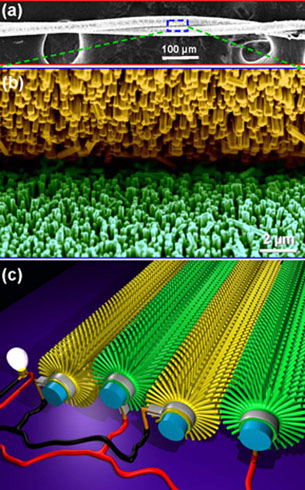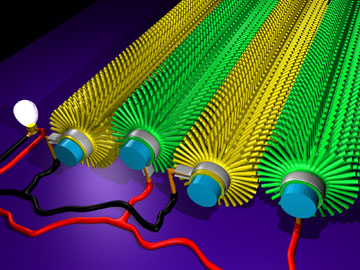Navigation
Remarkable New Shirt Harvests Energy from Wearer's Movement
Nanotechnology researchers at the Georgia Institute of Technology are developing a shirt that harvests energy from the wearer's physical motion and converts it into electricity for powering small electronic devices worn by soldiers in the field, hikers and other users.
Nanotechnology researchers at the Georgia Institute of Technology are developing a shirt that harvests energy from the wearer's physical motion and converts it into electricity for powering small electronic devices worn by soldiers in the field, hikers and other users.
 |
| Figure NG 1: (a) Scanning electron microscopy (SEM) image of two entangled microfibers that were covered radially with piezoelectric ZnO nanowires, with one of them coated with gold. The relative scrubbing of the two “brushes” generates electricity. (b) A magnified SEM image at the area where the two “brushes” meet teeth-to-teeth, with the top one coated with gold and the bottom one is as-synthesized ZnO nanowires. (c) A schematic illustration of the microfiber-nanowire hybrid nanogenerator, which is the basis of using fabrics for generating electricity. Images courtesy of Prof. Z.L. Wang and Dr. X.D. Wang, Georgia Institute of Technology |
The research, funded by the National Science Foundation (NSF) and described in the Feb. 14 issue of Nature, details how pairs of textile fibers covered with zinc oxide nanowires generate electricity in response to applied mechanical stress. Known as "the piezoelectric effect," the resulting current flow from many fiber pairs woven into a shirt or jacket could allow the wearer's body movement to power a range of portable electronic devices. The fibers could also be woven into curtains, tents or other structures to capture energy from wind motion, sound vibration or other mechanical energy.
"The two fibers scrub together just like two bottle brushes with their bristles touching, and the piezoelectric-semiconductor process converts the mechanical motion into electrical energy," says Zhong Lin Wang, a Regents professor in the School of Materials Science and Engineering at the Georgia Institute of Technology. "Many of these devices could be put together to produce higher power output."
 |
| Figure NG 2: A schematic illustration of the microfiber-nanowire hybrid nanogenerator, which is the basis of using fabrics for generating electricity. The fibers were first grown with radially distributed piezoelectric ZnO nanowires. The microfibers that are coated with gold (yellow color) scrub the microfibers that are not coated with gold produce electricity via a coupled piezoelectric-semiconducting process. This is the fundamental concept of “power shirt”. Images courtesy of Prof. Z.L. Wang and Dr. X.D. Wang, Georgia Institute of Technology |
Wang and collaborators Xudong Wang and Yong Qin have made more than 200 of the fiber nanogenerators. Each is tested on an apparatus that uses a spring and wheel to move one fiber against the other. The fibers are rubbed together for up to 30 minutes to test their durability and power production.
The researchers have measured current of about four nanoamperes and output voltage of about four millivolts from a nanogenerator that included two fibers that were each one centimeter long. With a much improved design, Wang estimates that a square meter of fabric made from the special fibers could theoretically generate as much as 80 milliwatts of power.
So far, there is only one wrinkle in the fabric, so to speak - washing it. Zinc oxide is sensitive to moisture, so in real shirts or jackets, the nanowires would have to be protected from the effects of the washing machine.
The research was funded by NSF's Division of Materials Research. "This multi-disciplinary research grant enables materials scientists and engineers from varied backgrounds to work together towards translating basic and applied research into viable technologies," said NSF Program Manager Harsh Deep Chopra.
The research was also sponsored by the U.S. Department of Energy and the Emory-Georgia Tech Nanotechnology Center for Personalized and Predictive Oncology.
The contents of this article are from the National Science Foundation (NSF) release of February 13, 2008.
The images are courtesy of Prof. Z.L. Wang and Dr. X.D. Wang, Georgia Institute of Technology
Program Contacts
Harsh D. Chopra, National Science Foundation (703) 292-4543 hchopra@nsf.gov
Principal Investigators
Zhong Lin Wang, Georgia Institute of Technology (404) 894-8008 zhong.wang@mse.gatech.edu
Related Websites
Professor Wang's Nano Research group: http://www.nanoscience.gatech.edu/zlwang/wang.html
Note:
The National Science Foundation (NSF) is an independent federal agency that supports fundamental research and education across all fields of science and engineering.
NSF Home Page: http://www.nsf.gov
NSF News: http://www.nsf.gov/news/
Science and Engineering Statistics: http://www.nsf.gov/statistics/
Awards Searches: http://www.nsf.gov/awardsearch/
Search
Latest articles
Agriculture
- World Water Week: Healthy ecosystems essential to human health: from coronavirus to malnutrition Online session Wednesday 24 August 17:00-18:20
- World Water Week: Healthy ecosystems essential to human health: from coronavirus to malnutrition Online session Wednesday 24 August 17:00-18:20
Air Pollution
- "Water and Sanitation-Related Diseases and the Changing Environment: Challenges, Interventions, and Preventive Measures" Volume 2 Is Now Available
- Global Innovation Exchange Co-Created by Horizon International, USAID, Bill and Melinda Gates Foundation and Others
Biodiversity
- It is time for international mobilization against climate change
- World Water Week: Healthy ecosystems essential to human health: from coronavirus to malnutrition Online session Wednesday 24 August 17:00-18:20
Desertification
- World Water Week: Healthy ecosystems essential to human health: from coronavirus to malnutrition Online session Wednesday 24 August 17:00-18:20
- UN Food Systems Summit Receives Over 1,200 Ideas to Help Meet Sustainable Development Goals
Endangered Species
- Mangrove Action Project Collaborates to Restore and Preserve Mangrove Ecosystems
- Coral Research in Palau offers a “Glimmer of Hope”
Energy
- Global Innovation Exchange Co-Created by Horizon International, USAID, Bill and Melinda Gates Foundation and Others
- Wildlife Preservation in Southeast Nova Scotia
Exhibits
- Global Innovation Exchange Co-Created by Horizon International, USAID, Bill and Melinda Gates Foundation and Others
- Coral Reefs
Forests
- NASA Satellites Reveal Major Shifts in Global Freshwater Updated June 2020
- Global Innovation Exchange Co-Created by Horizon International, USAID, Bill and Melinda Gates Foundation and Others
Global Climate Change
- It is time for international mobilization against climate change
- It is time for international mobilization against climate change
Global Health
- World Water Week: Healthy ecosystems essential to human health: from coronavirus to malnutrition Online session Wednesday 24 August 17:00-18:20
- More than 400 schoolgirls, family and teachers rescued from Afghanistan by small coalition
Industry
- "Water and Sanitation-Related Diseases and the Changing Environment: Challenges, Interventions, and Preventive Measures" Volume 2 Is Now Available
- Global Innovation Exchange Co-Created by Horizon International, USAID, Bill and Melinda Gates Foundation and Others
Natural Disaster Relief
- STOP ATTACKS ON HEALTH CARE IN UKRAINE
- Global Innovation Exchange Co-Created by Horizon International, USAID, Bill and Melinda Gates Foundation and Others
News and Special Reports
- World Water Week: Healthy ecosystems essential to human health: from coronavirus to malnutrition Online session Wednesday 24 August 17:00-18:20
- STOP ATTACKS ON HEALTH CARE IN UKRAINE
Oceans, Coral Reefs
- World Water Week: Healthy ecosystems essential to human health: from coronavirus to malnutrition Online session Wednesday 24 August 17:00-18:20
- Mangrove Action Project Collaborates to Restore and Preserve Mangrove Ecosystems
Pollution
- Zakaria Ouedraogo of Burkina Faso Produces Film “Nzoue Fiyen: Water Not Drinkable”
- "Water and Sanitation-Related Diseases and the Changing Environment: Challenges, Interventions, and Preventive Measures" Volume 2 Is Now Available
Population
- "Water and Sanitation-Related Diseases and the Changing Environment: Challenges, Interventions, and Preventive Measures" Volume 2 Is Now Available
- "Water and Sanitation-Related Diseases and the Changing Environment: Challenges, Interventions, and Preventive Measures" Volume 2 Is Now Available
Public Health
- Honouring the visionary behind India’s sanitation revolution
- Honouring the visionary behind India’s sanitation revolution
Rivers
- World Water Week: Healthy ecosystems essential to human health: from coronavirus to malnutrition Online session Wednesday 24 August 17:00-18:20
- Mangrove Action Project Collaborates to Restore and Preserve Mangrove Ecosystems
Sanitation
- Honouring the visionary behind India’s sanitation revolution
- Honouring the visionary behind India’s sanitation revolution
Toxic Chemicals
- "Water and Sanitation-Related Diseases and the Changing Environment: Challenges, Interventions, and Preventive Measures" Volume 2 Is Now Available
- Actions to Prevent Polluted Drinking Water in the United States
Transportation
- "Water and Sanitation-Related Diseases and the Changing Environment: Challenges, Interventions, and Preventive Measures" Volume 2 Is Now Available
- Urbanization Provides Opportunities for Transition to a Green Economy, Says New Report
Waste Management
- Honouring the visionary behind India’s sanitation revolution
- Honouring the visionary behind India’s sanitation revolution
Water
- Honouring the visionary behind India’s sanitation revolution
- Honouring the visionary behind India’s sanitation revolution
Water and Sanitation
- Honouring the visionary behind India’s sanitation revolution
- Honouring the visionary behind India’s sanitation revolution

